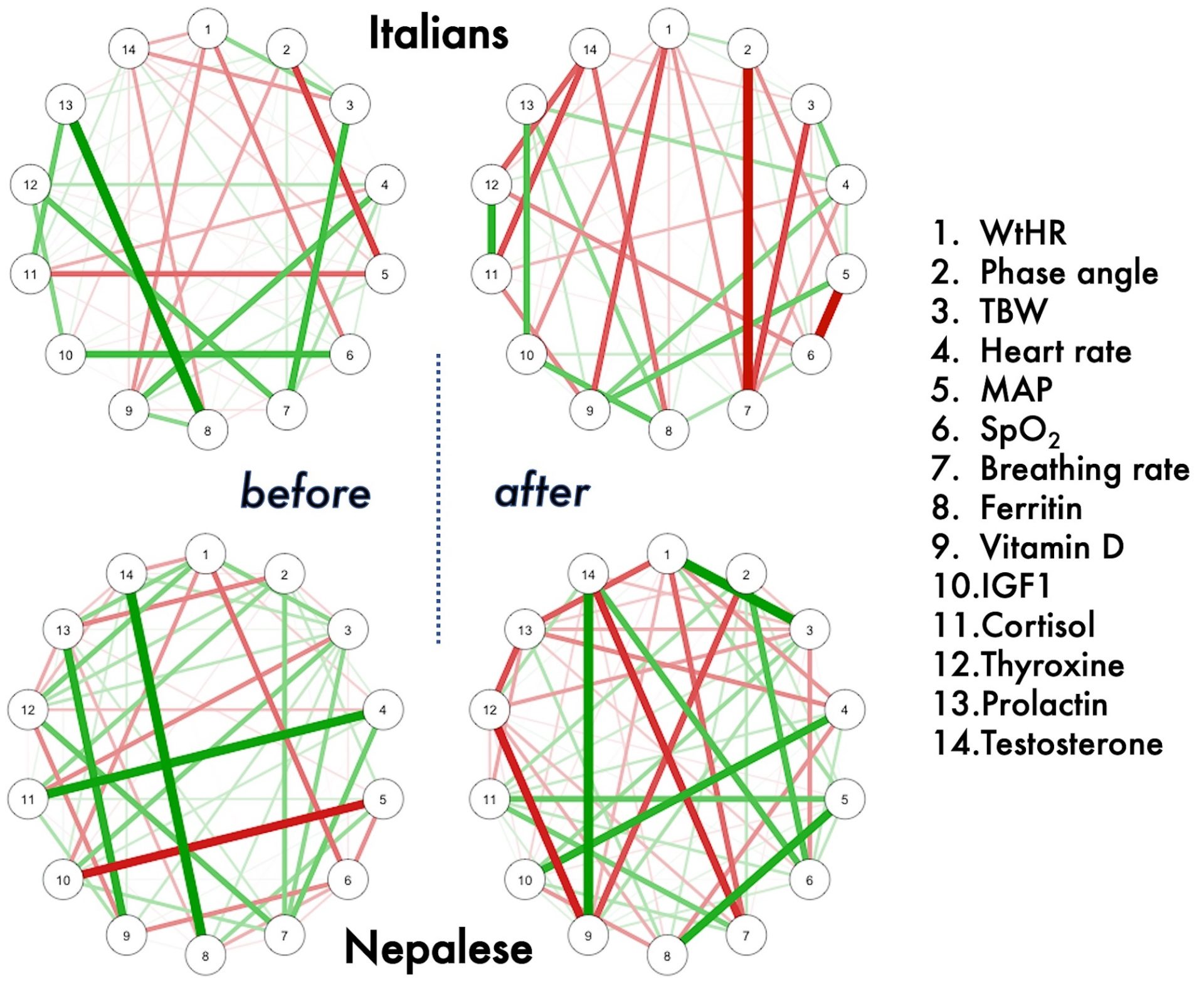Interconnectedness and adaptiveness paved the way for network physiology, as the science devoted to the analysis of the structure that links the components of complex physiological systems (1). Network science approaches rise the possibility of unveiling novel and meaningful insights for translational medicine and applied physiology. We used a network approach to evaluate ethnic differences, at baseline and in response to an altitude hypoxia trek (300 km distance in 19 days, up to 5,140 m of altitude), of five Italian trekkers (45 ± 17 years, BMI = 25.96 ± 3.61 kg/m2) and six Nepalese porters (30 ± 8 years, BMI = 24.36 ± 4.70 kg/m2), all males, taking part to the Himalayan expedition “Kanchenjunga Exploration & Physiology” (2). A subset of 14 out of 21 variables initially included were selected,consisting of anthropometric, endocrine and cardiorespiratory data. To reduce the number of variables, we checked Shapiro-Wilk’s test for normality and Leven’s test for homoscedasticity and run a linear mixed model obtaining Akaike and Bayesian information criterion (IC); then, among variables of the same physiological subsystem, we selected those ones with the lowest IC. Analyses were carried out with RStudio Version 1.1.456; comparisons were made with the “NetworksComparisonTest” package, and graphs were made with the “qgraph” package. Four graphs were built and compared; nodes were represented by physiological variables and edges by partial correlation coefficients. Aspects of invariant network structure and invariant global strength (3), along with the centrality measures of strength and expected influence, were calculated. The hyperparameter γ of EBICglasso estimation was set at 0.1 (4). The number of iterations of the permutation method for the significance test was set at 100. The most likely finding was the difference in pre vs post networks of Italians about invariance measures (p=.09 for both network structure and global strength). The difference for centrality measures was far from being significant. The low sample size, as a common pitfall in field studies at high-altitude, may have limited the robustness of comparisons about the differential response of centrality, for what concerned SpO2 and body fluids dynamics. It can be speculated that the physiological interconnectedness of Italian trekkers, rather than Nepalese porters, was more affected by the altitude trek. For further models, it can be recommended to consider both significance and coefficients’ threshold, dealing with the assumption to obtain an adequate balance for density/sparsity of graphs. Statistical testing of topological, whole structure, and centrality measures represents a valuable approach to compare correlation graphs, with possible original and meaningful insights for high-altitude physiology.
Future Physiology 2021 (Virutal) (2021) Proc Physiol Soc 47, PC35
Poster Communications: Physiological networks of response to high-altitude trek: porters vs trekkers
Danilo Bondi1, Tiziana Pietrangelo1, Stefania Fulle1, Vittore Verratti2
1 Department of Neuroscience, Imaging and Clinical Sciences, University "G' d'Annunzio" of Chieti - Pescara, Italy, Chieti, Italy 2 Department of Psychological, Health and Territorial Sciences, University "G' d'Annunzio" of Chieti - Pescara, Italy , Chieti, Italy
View other abstracts by:
Where applicable, experiments conform with Society ethical requirements.

